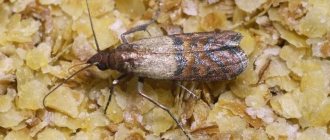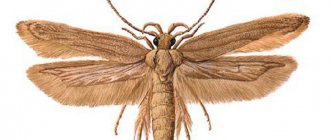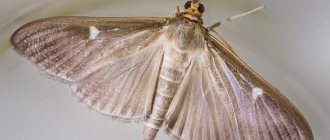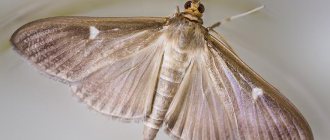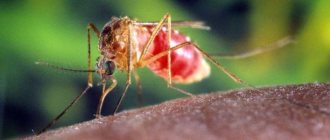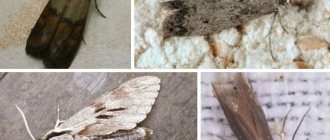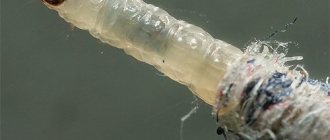Direct and indirect harm
When assessing the danger of moths appearing in an apartment, they first of all talk about spoiled products and things. This is direct harm, but there is also indirect harm. So, having discovered a food moth in a bag of flour, most housewives will throw away not only it, but also all nearby products, since they may also contain insects that have gone unnoticed.
As for clothes moths, indirect harm can be caused when trying to cope with them. For example, washing woolen items in hot water may cause them to change shape or size. The same applies to the use of untested means that can ruin the item.
Clothes
But the question of whether moths are dangerous for people is inappropriate in this case. The insect does not bite, does not carry pathogens, and therefore poses no direct harm to humans.
Main types of insects
Modern biologists know about forty families of common moths. Moreover, some of them live in our latitudes. The most voracious, and therefore dangerous for human habitation, are:
- Furniture moth eating upholstery materials. This species often lives in natural wood.
- Clothes moth. This insect causes damage to woolen products.
- Grain moth that lives in kitchens and eats all kinds of cereals.
The places where moths live are not only the kitchens of residential buildings, but also warehouses, where they eat all poorly sealed cereals. An unscrupulous manufacturer, having discovered insects in a product, knows that selling it even after careful selection is impossible, so he makes a significant markdown. By purchasing goods in stores at a reduced price or on promotions, the consumer risks bringing unfortunate parasites into the house. They do not pose any direct danger to human health.
However, irreparable damage is caused to food supplies, and few people will be pleased to find the corpse of an insect or its larva in a cup of tea or a vase of jam. In dry foods, cereals, dried fruits, the process of moth degeneration occurs, that is, it not only eats them, but lays eggs, which then turn into larvae, which are considered the main eaters of human food.
This entire life process takes place in the kitchen in food products, from which food is then prepared. But they are no longer suitable for consumption, as they are contaminated with live and dead moth larvae, the remains of adult individuals, and feces. After damage to insects, no one eats food anymore.
It is quite difficult to kill an insect with cotton, since it not only eats quickly and randomly, but also moves through the air, usually under the ceiling. Pests enter the active phase at night, during a safer and freer period for movement. At this time she eats everything. The food moth lives for no more than three weeks, but it is not advisable to hope for its disappearance and do nothing, because during this time it will leave a countless legacy in the kitchen as a gift.
Do moths eat and what do they eat?
Adults, that is, those gray-brown moths that are sometimes found in the room or kitchen, do not eat anything. They live off the nutrients that were accumulated at the larval stage, and their main task is to have time to lay eggs. But larvae (small white worms) are the same pests that actively destroy food and clothing.
What do food moths like in the kitchen?
Food moth is a common name for several types of insects that can live in the kitchen, feeding on various foods.
So, what does food moth eat:
- flour;
- cereals and grains;
- nuts and seeds;
- dried fruits;
- chocolate and candies;
- pasta;
- cookies, biscuits, crackers.
Each species prefers a certain product, but if necessary, it can eat something else. For example, fruit moths will not refuse cereals or cookies due to the lack of dried fruits.
Do food moths ruin clothes?
Despite the fact that all types of domestic moths are similar to each other, their food preferences are different. Food moth larvae will not eat clothing, just as the clothing or carpet varieties will not cause any harm to food.
What do clothes moths eat in the apartment?
If there are clothes moths in your apartment, they can ruin a lot of things. The following are at risk:
- products made from natural fur (sheepskin coats, fur coats, hats, fur collars on coats and jackets);
- items made of wool, linen, cotton, silk;
- shoes with fur or wool insulation;
- felt boots, felt woolen slippers;
- carpets and rugs;
- furniture upholstery.
There is an opinion that moths only eat clothes made from natural materials such as wool or cotton. But, unfortunately, insects adapt to the conditions in which they live, so semi-synthetic and even synthetic things are increasingly suffering from pests.
Danger to humans
This butterfly can live not only in kitchens, but also in industrial warehouses, where it spoils a huge amount of cereals intended for sale.
An unscrupulous manufacturer, having learned that moths have settled in his product, does not destroy it, but sells it at a slight discount (at best). By purchasing products at a reduced price, we can easily bring into the house not only them, but also everything that has managed to live in such a product. This butterfly does not pose a danger to human health. Food moths cause enormous damage to food products, and few people want to see a floating worm on their own plate. An adult moth does not have a proboscis and does not feed on our food, but lays eggs in it, from which larvae emerge that devour our food.
The fact that eating food moths (its larvae) becomes unsuitable, because the worms not only eat food, but also crap in it and die.
food moth
How to find out where moths have started?
To successfully cope with pests, you need to find as quickly as possible where the moth has settled in the apartment. Finding a place where insects accumulate is not easy at first. But the longer pests are in the apartment, the more signs of their presence appear, which means it becomes easier to find them.
To find a nest, you must first determine what type of moth has settled in the apartment. It is not difficult. If small gray butterflies fly around the kitchen, you need to look for the refuge of a food pest. First of all, you should check all bulk products that are stored in bags or unclosed containers. You should also check your kitchen cabinets and shelves. Lumps of sticky cereal, small debris, black dots, cobwebs - all this indicates the presence of insects.
Moth in the house
The nest of clothes moths should be looked for in closets with clothes, in the folds of furniture upholstery, and folded things. The remains of cocoons, waste products, and traces left on things from a feast of moth larvae will help you find the trail.
Features of reproduction
An insect that finds itself in a living room or has occupied crops begins to actively reproduce. This process takes place in four stages. First, the female lays eggs. They can be collected in one place or scattered throughout the area, which will later be occupied by parasites.
Those who do not know what moths eat will be interested in the fact that during the development and growth of the caterpillars, the previous generation of pests gradually dies out. This explains the noticeable decline in the number of flying butterflies.
Actively feeding larvae begin to increase in size. A well-fed individual pupates and spends about two months in its cocoon. After this period, a moth appears from there, looking like a chaotically flying butterfly.
If eggs are laid in early autumn, the larvae have to overwinter in woven cocoons. Individuals found inside living quarters continue to feed intensively, while all others hibernate until spring arrives. It should be noted that not all varieties of flying parasites are able to withstand winter frosts. With the onset of warmth, butterflies emerge from the cocoons, which, in turn, begin to reproduce their offspring.
How to get rid of moths and their larvae?
There are many means that you can use to control pests. Insecticidal preparations are considered the most effective; biological methods and folk recipes show good results.
Chemicals
Chemicals are mainly used to get rid of clothes moths. Not all housewives decide to treat their kitchens with toxic substances. But if there are a lot of insects, then you cannot do without chemicals.
Insecticides are available in the form:
- aerosols;
- emulsions;
- gels;
- plates or liquids for fumigators.
Chemicals must be used carefully, following the instructions and safety precautions.
Biological methods of control
Knowing what moths are afraid of, you can do without harmful chemicals in the fight against them. A safe way is exposure to low or high temperature. Larvae and adults die at temperatures below -10⁰С or above +50⁰С. In order to get rid of pests, clothes can be taken outside in winter, and food can be stored on the balcony or placed in the freezer for several hours. If we talk about heat treatment, then the cereals can be heated in a frying pan or in the oven, and things can be washed at high temperatures or treated with steam.
Use of folk remedies
Many people prefer to use safe and time-tested folk recipes. The most popular of them:
- essential oils (eucalyptus, fir, mint, lemon, grapefruit, clove, lavender);
- vinegar;
- ammonia;
- laundry soap;
- some spices (bay leaf, cloves, allspice);
- dried citrus peels.
All these products are repellents, that is, they repel insects. Soap and vinegar can be used during cleaning; peels, bags of spices and discs soaked in essential oils can be placed in cabinets and on shelves.
Food pest and fur coat
It is very difficult to fight food parasites. Measures must be taken as soon as the first signs of the appearance of food moths are noticed:
- flying gray butterflies in the kitchen;
- perforated grocery bags;
- larvae in cereals;
- caterpillars on furniture.
One adult food moth can lay more than 100 eggs per day; it is easy to guess how many larvae will be in the cereal when there are several of them. This will require a whole range of procedures to destroy the pest that eats food supplies.
The first thing to do is to review all food supplies; if insects are found, contaminated products are thrown away. Treat storage areas with chemicals to get rid of butterflies and their inheritance. The procedure is carried out after all products have been removed from the cabinets.
Adult butterflies are lured with sticky tapes and special traps. More advanced industrial methods have not yet been invented; the difficulty lies in the fact that the processing is carried out in food products. Important:
- Spoiled food is not thrown into a simple bucket, but burned or taken to a container located far from the house;
- You should not subject food to heat treatment, such as heating or freezing, these procedures do not give any effect only if the larvae are euthanized;
- There is no seasonality in the reproduction of this insect; you need to get rid of them immediately after detection.
useful links
Are moth baits effective and how do they work?
this link
.
If a moth appears in the kitchen, then do not worry that it has already eaten the clothes from the closet. Food moths do not eat things; their diet consists exclusively of cereals, nuts, dried fruits, flour, fruits, vegetables, bread and much more. Therefore, you shouldn’t worry about your things, although lockers and clothes also need to be checked from time to time just in case, so as not to miss the clothing type of insect.
It will be quite difficult to prevent the appearance because it is hardly possible to close all the vents, cracks, and make impenetrable door and window openings through which food moths enter the room. But it is quite possible to protect the foods that insects most often eat.
Naturally, a dirty kitchen full of specific odors attracts insects the most. You need to keep this room clean. Store products in sealed bags, jars and containers. It is worth periodically treating kitchen cabinets with disinfectants and putting repellents with food:
- mint;
- orange;
- lavender;
- black pepper.
Moths are attracted to worn clothes with traces of sweat and sebaceous secretions. This is why holes and abrasions often appear on cuffs, collars and other places in close contact with the skin.
Clothes moths are especially partial to natural wool: cloth, drape, woolen knitwear. It also affects fur: fur coats, hats, collars and other products.
The main preventive measure is frequent washing and cleaning of clothes. Dirty clothes should not be stored in the wardrobe. Attracted by the smell of greasy secretions, moths will ruin not only them, but also clean clothes hanging nearby. Items should be washed frequently or taken to dry cleaning periodically.
Thorough cleaning is also necessary for seasonal clothing and accessories sent for long-term storage: fur coats, jackets, hats, felt boots.
Fur mittens, shoe trim, and bags made of fabric or fur need to be cleaned periodically.
Some dry cleaners offer an additional service: a non-toxic anti-mole treatment that lasts for several months.
Frequent cleaning of the inside of your closet will also help protect your clothes. You need to go through your wardrobe at least once a season. Moths love secluded corners where fresh air and sunlight do not reach.
It is important to frequently rearrange clothes folded in piles: sweaters, cardigans, scarves, warm tights. Clothes on hangers should not hang too tightly; gaps should be left between items for ventilation. When going through your wardrobe, it is recommended to shake things; it is better to do this outdoors.
It is useful to hang woolen items in the hot summer sun. Bright rays negatively affect moth eggs and kill already hatched caterpillars. Frost has a similar effect. Hanging fur coats, coats and suits on the balcony in sub-zero temperatures helps prevent the appearance of clothes moths.
ADVICE! At the end of the winter season, it is better for owners of expensive fur coats, fur coats and stoles to store their items in special refrigerators. This service is offered by large fur salons or dry cleaners.
Consistently low temperatures kill moth larvae, the fur retains its attractive appearance longer, does not fade or become covered with dust.
Covers will help protect clothes - an excellent anti-moth remedy for fur coats. They are needed for seasonal clothing made of drape, mixed fabrics and fur, which moths especially love.
We invite you to read: How to remove food moths and their larvae from an apartment: folk remedies
Coats, fur coats, jackets, suits and dresses are stored in covers; they are suitable for transportation and protect clothes from dust.
Products can be purchased at hardware stores (for example, the Raptor brand); the best options for storing valuable mink and sable coats are offered in specialized fur salons.
The best covers are made from modern synthetic materials that do not interfere with normal air exchange. They are hermetically fastened with a zipper or Velcro tape.
Products may be impregnated with repellent drugs. Such covers are very effective, but anti-moth impregnations are toxic and not suitable for allergy sufferers.
Soaked products should be protected from children and pets; clothes packed for storage should be placed in the closet so that they do not touch other things. It is advisable to allocate a separate section for it. Impregnated anti-moth covers remain effective for up to 12 months.
An alternative could be a product made from thick cotton or thin plastic. You can make a convenient case yourself.
The style is simple: a rectangle with a sewn bottom and a zipper along the entire length. The size depends on the length of the product; the coat or fur coat should fit into the case freely, without tucking.
Hand-sewn covers must be washed every year after the end of the storage season. They can be treated from the inside with aerosol preparations that repel moths. At home, it is better to use odorless preparations. They irrigate not only the covers, but also the walls of the wardrobe.
Fur products are threatened by leather beetles and fur moths. But even ordinary clothes are partial to fur coats, hats and collars.
REFERENCE! The larvae gnaw the pile, leaving noticeable bald spots on fur coats. Most often, the sleeves, front and back, as well as the area at the collar are affected.
Insects are especially partial to short-haired fur: astrakhan fur, astrakhan fur, and mink. Moths can also damage the lining, leaving holes in it. Having noticed the slightest signs of pests, you need to urgently take measures to save your favorite fur coat.
A moth has eaten my fur coat, what should I do? The product is removed from the wardrobe and placed on wide hangers. It is best to hang the fur coat in a cool room: on a glassed-in loggia or veranda. First, the fur is cleaned with a brush from the outside and inside. Then the fur coat must be thoroughly shaken, removing moth larvae and eggs.
The fur coat is generously sprayed with a repellent designed to destroy moth larvae.
For home use, products that are unscented or have a neutral lavender scent are suitable. Choose drugs with minimal toxicity.
It is better to carry out work with gloves, protecting the respiratory tract with a gauze bandage. Not only the top of the fur coat is processed, but also the lining and the inside of the sleeves. Carefully spray the area under the collar or hood, cuffs, decorative elements, and folds.
ADVICE! It is convenient to process a very wide fur coat in a horizontal position, laid out on a table or ironing board.
Do not use repellents that have expired; they are practically useless. You cannot use several products from different manufacturers at the same time; many drugs do not combine with each other, forming harmful fumes.
After treatment, the fur coat is left for half an hour and then placed in a sealed case with anti-moth impregnation. It is better to leave the product outdoors for 1-2 days, and then put it in a separate section of the closet. Before placing the fur coat in the wardrobe, you need to treat the walls and shelves with repellents and ventilate thoroughly.
You should not place wool products stored without covers next to your fur coat. It is better to remove felt boots, yarn supplies and other items that attract moths from the section where fur is stored.
It is very difficult to completely eradicate clothes moths. However, timely preventive measures, hygiene and attention to your own wardrobe will help keep your clothes intact. It’s important to remember that preventing pests is easier than making them leave your home forever.
The common moth looks like a relatively small and completely harmless butterfly. However, in addition to adult individuals, there are also larvae that are consumers of keratin, easily obtained from wool fibers, carpet pile and fur coats. They leave behind waste products that clog the “former lunch spots.”
Of course, not a single face can completely destroy a carpet or fur coat, but the thing will still be damaged, since several rather large holes will appear in it. Those who study what moths eat are sure that in one day each individual is capable of chewing through a woolen or wool-blend product.
Clothes moth
Many housewives who notice a butterfly in the kitchen cabinet begin to worry about whether food moths can eat clothes. If you notice butterflies of food representatives of the moth, then you don’t have to worry about cashmere coats and fur coats - this insect only eats our food. The moth enzymes that break down the product are too “weak” and cannot cope with thick fibers.
Repellent methods
In addition to insect killers, repellents can be used. The moth does not tolerate sharp, rich odors, sunlight and is quite sensitive to temperature and humidity. Housewives actively use this knowledge in pest control.
What plants will help fight moths?
Indoor plants are a great way to decorate the interior of an apartment and at the same time repel moths. Geranium, mint, fragrant tobacco - pots with these plants can be placed in the room or in the kitchen. Their aroma will force insects to leave the room.
Sachet with wormwood
Dried herbs are another way to repel pests. Moths don't like the smell:
- wormwood;
- lavender;
- tansy;
- valerian;
- oregano;
- rosemary.
Plants are laid out in small linen bags, which are placed on kitchen shelves and in closets with clothes.
Synthetic scents
Remembering what else repels moths, we cannot ignore special products with a synthesized odor. Manufacturers use odors that pests do not like and impregnate products such as:
- sachet;
- sections;
- pills.
They are placed in places where insects are most likely to accumulate - in kitchen and wardrobes, on mezzanines. A product that smells unpleasant to insects forces them to leave their homes. If there are no insects, sachets and sections are used for prevention purposes.
Temperature, humidity, light
Sunlight is what moths, especially their larvae, don’t like. Darkness, temperatures ranging from +23 to +28⁰С, and humidity above 50% are optimal conditions for the development of pests. Therefore, another way to repel moths is to regularly ventilate cabinets, hang things outside in sunny weather or under the light of an ultraviolet lamp. A significant increase or decrease in temperature will also cause discomfort to the insects and may cause them to leave.
Preventing moths
Simple rules will help you avoid the appearance of moths in the house, and therefore spoiled things or eaten food:
- clothes and closets where they are stored must be ventilated periodically;
- You should not stock up on a lot of bulk products;
- store cereals, dried fruits, nuts and other foods that moths eat in tightly closed glass or metal jars;
- Regularly clean kitchen cabinets and check the condition of food;
- Seasonal items should be stored only after washing or dry cleaning.
In addition, for prevention purposes, you can place bags of dried herbs that repel moths in your closets, or use special sachets or tablets.

